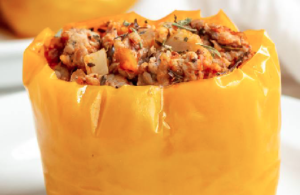
Ugh! Have you been sneezed on lately? If you’re out in the world, then chances are yes – since cold and flu season is in full swing.
I get asked a lot how I (99% of the time) avoid catching a cold when others around me – including in my own household! – are suffering (and sniffling!).
Here are my tips (and a yummy recipe to give you some cold-busting nutrition!):
1. Wash your hands! A lot!
Colds are caused by a virus and this pesky microbe can indeed live on surfaces for up to six hours. So if you’ve touched a handrail on public transit or opened a door at work that some germy fellow human has also touched – you’re vulnerable. Do not use antibacterial wash – for starters, a cold is not a bacterial infection. Further, we now know that overuse of all antibacterial products is likely causing all kinds of disruptions in our own microbiome which may be leading us to all kinds of digestive upsets and disease. Hot water and soap is plenty.
2. Keep your immune system strong by consuming lots of antioxidants on an ongoing basis.
Antioxidants – from a wide variety of plants in your diet – help protect your body from free radical damage at the cellular level. This includes your immune cells (T-cells, natural killer cells, macrophages, etc) that seek out and destroy germ invaders of all types from the common cold to cancer.
If your immune system is compromised, you won’t have a strong enough army to knock out the enemy when it comes knocking.
Fruits, nuts and especially veggies are potent sources of antioxidants. I do eat a plant-strong diet, meaning that I have veggies, nuts and/or fruits at every meal and try to make 50% of each meal or snack a plant.
On the flipside of this equation – limit those foods that weaken your immune system. Toxic foods – like those processed, chemical-laden ones that come from the middle section of the grocery store – as well as the #1 culprit for debilitating your ability to fight a germ – sugar!
Yes as far back as 1973 there’s been evidence that consumption of carbohydrates, in the form of sugars not starches, will affect the function of neutrophils, one type of white blood cell. Recently – like after the holidays – I’ve made an effort to eliminate all added sugar and sugary foods/beverages (including alcohol!) from my diet. I knew it was affecting my sleep and my energy balance and with everyone around me sneezing and hacking – well, I want every defence mechanism possible in place!
3. Both as prevention and to halt potential illness in its tracks, my secret weapon is oil of oregano.
This natural substance is extracted from the wild oregano plant and should not be confused with the one you use in your kitchen – although that also contains some healthful properties. Caryacrol and thymul are the active compounds in the oil and studies have shown that both of them have significant effects on harmful microorganisms that cause many illnesses in humans.
A few drops under the tongue (to allow the fastest entry into your blood stream) at the first sign of the sniffles can help give your body a boost to fight off the cold germs you may have been exposed to.
The taste takes some getting used to – but I have seen it work with many people and kids who start to feel under the weather. One caution: if you are pregnant you should avoid it. Oil of oregano may impact absorption of iron which is important during pregnancy, and could also stimulate blood flow in the womb which might impact the lining that surrounds the baby.
4. Vitamin D, C and E are all potent warriors against colds.
Let’s start with Vitamin D which plays an important immune-regulatory role. Everyone should be taking Vitamin D supplementation. Our bodies can make it – but we need sunshine on our skin and that’s a huge challenge in the northern hemisphere for most of the year. I always suggest at least 2000 IUs a day and 4000 during the dark winter months when 20 minutes of sunshine on our bare skin is impossible.
Vitamin E is another antioxidant that has demonstrated effectiveness in reducing the risk of respiratory infections. It also helps to reduce oxidative damage to the heart that can lead to heart disease. One of the best places to find Vitamin E is in sunflower seeds. Just ¼ cup of raw seeds as a snack or sprinkled on oatmeal or yogurt can help to boost your Vitamin E status.
Finally – the Grand-daddy of the cold busters – Vitamin C! We’ve heard for years that increasing our intake of Vitamin C will prevent us from getting a cold. Sadly, modern science is conflicted on the idea of cold prevention. However, there is evidence that Vitamin C will reduce the duration and severity of a cold should you contract one. And even better news – Vitamin C is very important in preventing the progression of atherosclerosis and reducing cellular DNA destruction which is the kick-off to the growth of cancer cells.
How do we ensure that that we are getting enough Vitamin C in our diets? The first thing everyone thinks of is citrus fruit, right? An even better source – with 2X more Vitamin C per serving is the Bell Pepper!
Just one cup of juicy red, orange or yellow peppers (not green as they are not fully ripened) will give you 157% of the Vitamin C you need for the day.
Peppers are bursting with phytonutrients – like carotene, lycopene, lutein, zeaxanthin- which are compounds that help to reduce the risk of cancer and age-related macular degeneration which is the leading cause of blindness for people over the age of 60.
Here’s a recipe to help you get your daily dose of Vitamin C, during cold season and beyond.
Stuffed Red Peppers
Serves 2
Ingredients:
- 2 red, yellow or orange peppers*
- 1 tbsp grapeseed or olive oil
- 1 medium onion, finely chopped
- 2 cloves garlic
- 1 cup shredded carrot
- 20 cherry tomatoes, cut in half
- 1 tbsp smoked paprika
- 2 tsp cumin
- ½ tsp crush red pepper flakes (optional)
- 8 oz of ground turkey or chicken
- 2/3 cup low fat mozzarella cheese or 3 oz goat cheese or feta cheese
- chopped cilantro
- guacamole (optional)
* you can use green peppers if you wish but as they are not ripened, they have less nutritional value
Directions:
- Cut the peppers in half lengthwise. Remove seeds and stems.
- In a sauté pan, heat the 1 tbsp of oil, add the onions, garlic, carrots and cook for 3-5 minutes until softened.
- Sprinkle in the spices and tomatoes and cook until tomatoes are soft.
- Spoon veggies into a large bowl and set aside.
- Heat the second tbsp of oil in the sauté plan and add chicken/turkey. Sauté until browned.
- Add meat to bowl of veggies and mix.
To assemble:
- Set the pepper halves, hollow side up, in a baking dish.
- Sprinkle a bit of cheese in the bottom of each half.
- Fill the peppers right up to the top with the meat filling, pressing it down a bit to make it firm.
- Top each with the remainder of the cheese
- Place the dish in a pre-heated 375F oven and bake for 30 minutes or until the peppers are tender.
To serve:
- Top with chopped cilantro and a spoon of guacamole.
Sources:
http://ajcn.nutrition.org/content/26/11/1180.abstract
http://www.theglobeandmail.com/life/health-and-fitness/statscan-finds-widespread-vitamin-d-deficiency-in-canadians/article596998/
http://www.statcan.gc.ca/pub/82-624-x/2013001/article/11727-eng.htm
https://www.nutritionletter.tufts.edu/general-nutrition/are-you-getting-enough-vitamin-e-from-your-diet/
http://www.lifeextension.com/magazine/2008/4/newly-discovered-benefits-of-vitamin-c/Page-01
